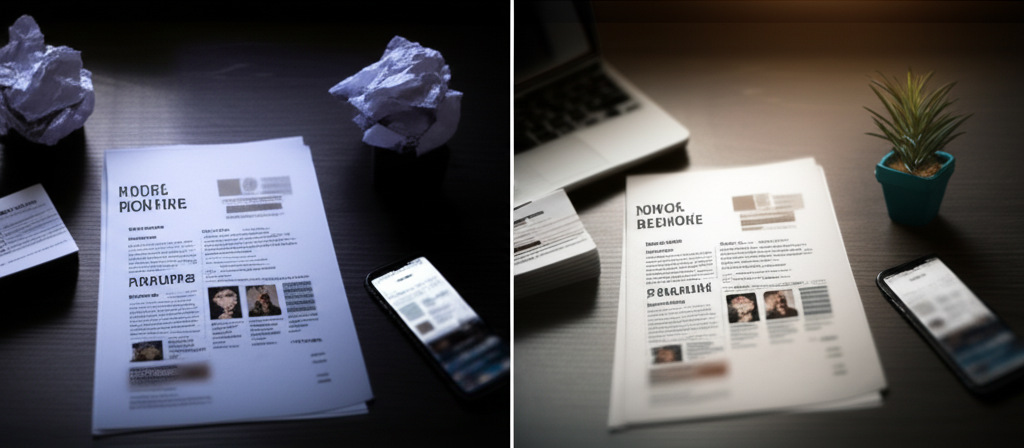Does your resume say "Data Analyst," your LinkedIn profile scream "Marketing Enthusiast," and your personal website show off old graphic design projects? When your professional story is scattered, recruiters and potential clients get confused—and move on. This isn't about having a perfect career path; it's about presenting a clear, consistent narrative that proves you're the right person for the job right now. We'll show you how to audit your online presence and build a powerful, aligned professional trifecta that opens doors.
Key Takeaways
- Recruiters Triangulate: Decision-makers don't just look at one profile. They cross-reference your resume, LinkedIn, and personal site to verify your claims and get a full picture. Inconsistencies are a major red flag.
- Consistency Builds Trust: A cohesive professional brand across all platforms makes you look focused, organized, and trustworthy. A fragmented presence creates doubt.
- Each Platform Has a Role: Your resume proves your past results, LinkedIn showcases your network and social proof, and a professional page or personal site provides the space for your full story and portfolio.
- Adopt a Framework: Use a simple system like the A.C.E. (Audit, Consolidate, Execute) framework to systematically align your professional identity everywhere it appears online.
- Control Your Narrative: By aligning these three core assets, you take control of how you're perceived online, ensuring the first impression is the one you want to make.
Why Your Inconsistent Online Presence Is Costing You Opportunities
You’ve spent hours tailoring your resume, but if it doesn't match what a recruiter finds online, that hard work is wasted. In today’s hiring landscape, your digital footprint is just as important as your PDF application.
The Recruiter's 60-Second "Triangulation" Check
Hiring managers are busy. They often perform a quick but critical check by looking you up on LinkedIn and doing a quick web search. They're trying to answer a few simple questions: Does this person’s story check out? Are they who they say they are? Is their experience consistent with the role I'm hiring for?
They "triangulate" your credibility by comparing your resume, your LinkedIn profile, and any personal website that comes up. If these three sources tell three different stories, it creates a puzzle they don’t have time to solve.
Red Flag: When Your Resume and LinkedIn Tell Different Stories
Imagine a recruiter sees a resume with the headline "Senior Project Manager" but clicks to a LinkedIn profile that says "Operations Specialist & Aspiring Coder." Immediately, questions arise. Which one is it? Are they focused? Is their resume an exaggeration? This disconnect is a primary reason candidates get passed over.
Before: A resume headline is "Senior Software Engineer," but the LinkedIn headline is "Tech Enthusiast & Blogger."
After: Both headlines are unified: "Senior Software Engineer | Python, AWS, & Distributed Systems." The 'after' version is specific, consistent, and instantly communicates value.

Data Check: What 2025 Stats Say About Online Vetting
This isn’t just speculation; the data backs it up. According to recent findings from StandOutCV, a staggering 77% of employers use social media to screen candidates before hiring. Furthermore, with 92% of companies using AI in their hiring process (as reported by ResumeBuilder.com), automated systems are also flagging inconsistencies in keywords, job titles, and timelines across your various profiles.
An inconsistent presence is no longer just a minor oversight—it’s a data-driven dealbreaker.
Introducing the A.C.E. Presence Framework
Getting your professional story straight doesn't have to be complicated. The A.C.E. Presence Framework is a simple, three-step system to audit your brand, define your core narrative, and apply it consistently across your key assets.
Step 1: AUDIT Your Current Professional Footprint
You can't fix what you don't know is broken. Start by cataloging every public-facing professional asset you have. Open your resume, your LinkedIn profile, your personal website or portfolio, your Twitter bio, and any other professional profiles in separate tabs. Look at them with the eyes of a recruiter. Where are the disconnects?
Step 2: CONSOLIDATE Your Master Narrative
Now, define your single "master narrative." This is your core professional identity, boiled down to a few key elements. Ask yourself:
- What is my primary job title or professional identity? (e.g., "UX Designer," "Content Strategist," "Full-Stack Developer")
- What specific value do I offer? (e.g., "...who specializes in mobile-first design for SaaS companies.")
- What are my 3-5 core skills? (e.g., Figma, User Research, Prototyping, A/B Testing, HTML/CSS)
Write this down. This is your source of truth.
Step 3: EXECUTE Across Your Trifecta
With your master narrative defined, it's time to deploy it. The goal isn't to make every platform identical, but to make them thematically consistent. Each piece of the trifecta serves a unique purpose.
Feeling fragmented? Use our free Professional Page Builder to create the central hub for your brand in under 10 minutes. It’s the easiest way to control your story.
How to Tune Each Piece of The Trifecta
Think of your professional presence as a unified system. Your master narrative is the core message, but you'll adapt its delivery for each platform's specific audience and format.
The Resume: Your Document of Proof
Your resume is the evidence-based, factual record of your accomplishments. It should be tailored to a specific job, but its core information—job titles, dates, and key skills—must be the rock-solid foundation that everything else is built upon. Use a modern resume builder to ensure it's clean and ATS-friendly.
- Focus: Quantifiable achievements and results.
- Action: Align your summary and skills section with your master narrative. Ensure job titles and dates are 100% consistent with your LinkedIn.
LinkedIn: Your Network & Social Proof
LinkedIn is your dynamic, networked presence. It’s where recruiters validate the information on your resume and look for social proof through recommendations, connections, and activity. Your headline and "About" section should be a direct reflection of your master narrative.
- Focus: Networking, social proof, and professional brand reinforcement.
- Action: Make your headline a powerful statement of your value. Use your "About" section to tell a slightly more personal story around your master narrative. Get recommendations that validate your core skills.
The Personal Site: Your Hub of Credibility
Your personal site or digital portfolio is the only platform you truly own. It’s your credibility hub where you can go deeper than a two-page resume allows. This is the place to showcase your work, share case studies, and let your professional personality shine. For many, a simple and powerful Livesume page is the perfect solution, acting as a central anchor for your brand.
- Focus: Deep-dive evidence, personality, and direct contact.
- Action: Create an Impact Portfolio that shows the results of your work. Write a bio that tells your story. Make it incredibly easy for potential clients or recruiters to get in touch.

The Professional Trifecta Audit: A 10-Point Checklist
Use this checklist to score your own professional presence. Go through your resume, LinkedIn, and personal site and see how they stack up.
- Headlines Match: Is your professional title/headline consistent across all three platforms?
- Core Skills Are Identical: Are the top 3-5 skills listed on your resume the same ones highlighted on LinkedIn and your website?
- Profile Photos Are Cohesive: Do you use the same professional, high-quality headshot on LinkedIn and your personal site?
- Job History Aligns: Are the company names, titles, and employment dates exactly the same on your resume and LinkedIn?
- Contact Info is Centralized: Do all platforms point to your preferred method of contact (e.g., your personal site's contact form)?
- Bio/About Sections Tell the Same Story: While the tone may vary, does the core narrative of who you are and what you do remain consistent?
- Portfolio Links Are Live: Do the portfolio links on your resume and LinkedIn go to a functioning, up-to-date personal website?
- Keywords Are Consistent: Are you using the same industry-specific keywords to describe your skills and experience everywhere?
- The "Why" is Clear: Can someone understand your primary career goal or specialty within 10 seconds on each platform?
- The Call to Action is Obvious: Is it clear what you want the visitor to do next (e.g., "Contact me for freelance projects," "View my work")?
From Fragmented to Focused: A Quick Example
Let's look at a freelance web developer.
Before:
- Resume: Lists "Web Developer" but focuses on backend skills like PHP and MySQL.
- LinkedIn: Headline is "Freelancer | WordPress & Shopify Expert."
- Website: A dated portfolio showcasing old design projects, with no clear service offerings.
Result: The client is confused. Are they a backend developer, a WordPress specialist, or a designer? This friction leads to a lost opportunity.
After Applying the A.C.E. Framework:
- Master Narrative: "Freelance Shopify Developer for E-commerce Brands."
- Resume: Tailored to highlight Shopify development projects and e-commerce results.
- LinkedIn: Headline is "Freelance Shopify Developer | Helping E-commerce Brands Increase Conversions."
- Website: A clean services page clearly outlining Shopify development packages, featuring case studies from e-commerce clients.
Result: The story is crystal clear. The developer attracts their ideal clients and can command higher rates because they are positioned as a specialist.

Frequently Asked Questions
Should my resume and LinkedIn be exactly the same?
No, not exactly. Your core information—job titles, companies, dates, and key skills—should be identical. However, the tone and purpose differ. Your resume is a formal document of proof, while your LinkedIn profile is a more dynamic, first-person networking tool. Use the "About" section on LinkedIn to add more personality.
What should I put on my personal professional website?
Your site should be your credibility hub. Include a clear headline of who you are and what you do, an expanded bio, a portfolio or case studies of your best work, testimonials or social proof, and a clear way for people to contact you. Think of it as the ultimate destination you want recruiters and clients to land on.
How do recruiters check candidates online?
Most recruiters start with your LinkedIn profile to verify the information on your resume. They'll look for consistency in your job history and skills. Many will also perform a quick Google search of your name to see what else comes up, which is why having a professional personal site you control is so valuable.
Do I need a personal website if I have LinkedIn?
Yes, for three key reasons: 1) You own and control 100% of the content and branding on your site. 2) It allows you to showcase your work in-depth via a portfolio, which LinkedIn doesn't do well. 3) It signals that you are a serious professional who invests in their own brand. A simple professional page can cover this perfectly.
Can a portfolio website replace a resume?
Not entirely, but it's getting closer. Many companies still require a resume for their Applicant Tracking Systems (ATS). The best strategy is to have both. Your resume gets you through the initial screening, and your portfolio website wins you the interview by providing rich, visual proof of your skills.
What's the fastest way to create a consistent brand?
Start by defining your master narrative (your core title, value, and skills). Then, update your LinkedIn headline and "About" section. Finally, create a simple one-page personal site using a tool like Livesume to act as the central hub that your resume and LinkedIn can point to.
What are major red flags on a LinkedIn profile?
Major red flags include: a profile picture that is unprofessional or missing, a headline that doesn't match the resume, large gaps in employment that aren't explained, a sparse network with few connections, and a lack of recommendations or endorsements for key skills.
Turn Your Aligned Presence Into Your Next Opportunity
Stop letting a fragmented online presence undermine your expertise. A clear, consistent, and compelling professional trifecta doesn't just make you look good—it builds the trust and credibility needed to land better opportunities. You're not just organizing profiles; you're building a system that works for your career 24/7.
Your Next Steps:
- Run the 10-Point Trifecta Audit: Take 15 minutes right now to score your own presence. Identify the biggest gaps.
- Define Your Master Narrative: Write down your core title, value proposition, and top 5 skills. This is your anchor.
- Build Your Credibility Hub: Your strongest professional brand is a consistent one. Start building the anchor of your Professional Trifecta today. Create your Livesume page for free.